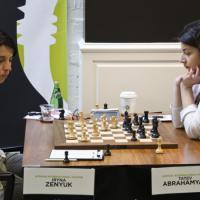
Endgames in the US Championship
My vacation from chess.com is over and I cannot wait to share with you the endgame experience that I acquired during the recent US and US Women's Championships. I participated in the Women's Championship and finished tied 5-7 with a 50% score, what is a decent result. I am happy about some of the games that I played, demonstrating solid endgame technique. Today I would like to share with you the endgame that happened in the 3rd round of the Championship in my game against WGM Tatev Abrahamyan. I blundered in the opening and survived an attack in the middlegame, so by the time we reached the endgame I was happy just to save the game. However, at the control move Tatev offered a draw and I declined it because my intuition told me that it is only white who could try playing for the win in that position. Let us analyze the endgame in detail.
First, how to evaluate this bishop v. knight endgame? Both sides have scattered pawns. White has the advantage of two pawns being connected: the c- and the d-pawns. The black d6-pawn is on a dark square and can be attacked by the knight. The d3-pawn is a weakness because black will end up either giving it up or tying the bishop to its defense. The white king is closer to the center which also constitutes a small advantage for white. Overall, the position is probably equal but it is easier to play it with the white pieces. White can fix the weakness on the b-file with the move c4, then the knight can attack both the d and b-pawns. The black king can defend both, so the question will be whether white manages to create a second weakness in the position.
We both were in time-trouble and given such a short time for thinking, even evaluating the position was challenging. Here, black could have right away forced a draw using an idea that the knight on c7 is misplaced. Bringing the king into the game is more important than wasting two tempos with the bishop by picking up the doubled g-pawn and protecting the weakness on d3. Even after the bishop maneuver the position remains close to equality.
Over the last few moves white made progress by activating the king and fixing the black pawns on the queenside. White is threatening to win the b6-pawn after Na8. The only way to defend it is to push the pawn forward to b5 after Bd7. This is a passive defense, which Tatev played during the game. In time-trouble this solution is understandable but it involves the d3-pawn sacrifice. If you compare the b6 to the d3-pawn, which one would you rather give up? The solution is not hard to find if you answer this question.
In the next stage of the game I will try different plans to see how black defends. The best set-up for black is the modest Bd7 - Kf6. The bishop from d7 controls the b5 and f5-squares, so the knight cannot really get in. If the knight steps away, the freeing b5 is a threat. If the knight goes to f5 then black will take the knight and with the king on f6 white has to recapture with the pawn which benefits black due to the outside passed h-pawn. Tatev played Bh3 with the idea to attack the c4-pawn from behind. The idea is active and I didn't find the right counter-attack. The disadvantage of the Bh3 move is that after g4 the f5-square becomes undefended. When the knight lands on f5 both the d and h-pawns will hang. White does not need to rush with taking either pawn but can instead defend the d5-pawn after B:c4. The following annotation to the game illustrates these variations.
After maneuvering for a while I set-up a trap that in time trouble Tatev did not uncover. White can play this position for a long time trying different plans and it is a correct strategy. Black is under pressure and most likely will make a mistake at some point. The bishop is under attack and has to retreat to g2 or h3. One move loses the other manages to hold the position. Do you see the trap that white set up?
You can call it luck but you will find that it is extremely hard to defend a slightly worse position for a long time. Black lost the game due to the misplaced bishop. The bishop's ideal position was on d7 and not on g2, where it got trapped. The strategy that white used was to slowly try different plans and to breach black's position from different flanks. Tatev defended very well for a long time and only at the very end in time-trouble missed the final trap. Still white had to be precise in the resulting endgame because black got a few pawns for the knight.






